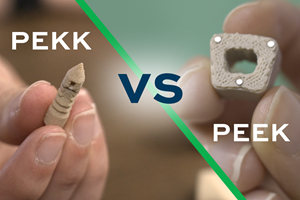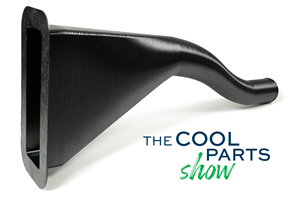3D Systems’ SLS 300 Enables Advanced SLS Technology in Smaller Manufacturing Environments
A new Powder Recycling Station (PRS) is an optional accessory available in 2024 which works in tandem with the printer to automatically recycle unused powder currently in the system and mix it with fresh material.
3D Systems has expanded its selective laser sintering (SLS) portfolio with the SLS 300, which is an affordable, turnkey, closed-loop system. The SLS 300 is designed to operate in a smaller footprint environment outside of a manufacturing floor, such as offices, material research labs or workshops. This makes SLS available to a broader range of customers with a high-reliability, affordable solution for the production of end-use parts.
The SLS 300 (formerly the Wematter Gravity) makes it possible to accelerate product development and in-house volume production with increased flexibility, lower risk, and reduced manufacturing and development costs. The system is an easy-to-install ecosystem that only requires a standard power source and an ethernet connection to be operational in less than an hour.
The system is well suited for prototypes, functional parts, small complex parts, parts for the automotive industry, medical supplies, pipelines and fittings for water pipes, and industrial components. The system is compatible with a broad material portfolio to address a breadth of applications. Users can produce tough, durable parts from a range of production-grade nylon materials. Choose from tough, impact- and fatigue-resistant nylon 11 materials or strong, or flame-retardant nylon 12 thermoplastics and filled nylons.
The patented packaging ensures users do not come into direct contact with any powder when filling the machine. The cylinders, made of sustainable paper and wood-based packaging, directly connect to the printer and fill it via a dedicated inlet on the front to keep the process dust-free. Each cylinder includes a QR card that helps ensure the correct material is loaded into the correct printer.
The system offers a new Powder Recycling Station (PRS) which is an optional accessory planned to be available in 2024. This unit works in tandem with the SLS 300 printer to automatically recycle unused powder currently in the system and mix it with fresh material. It enables the ability to use all material to maximize a user’s investment while lowering production costs and reducing demand for human intervention. The PRS includes HEPA filters and was designed with acoustic dampening which enables it to be used comfortably in a variety of environments.
The system simplifies SLS Technology with a plug-and-play format. This means users can print SLS-quality functional prototypes, tools and more without the need for specialized staff, investments in infrastructure and complex powder handling. The SLS also prints parts with mechanical properties as strong as injection molding without the need for complex infrastructure or expertise. It uses standard power, is low in office noise levels and requires no chiller or fume extractor.
This customizable 3D printing solution is available in two packages with optional accessories. The SLS 300 offers a 300 × 300 × 150-mm build volume at 10 mm/hr. It supports PA11 Black material. The SLS 300 Plus offers a 300 × 300 × 300-mm build volume at 12 mm/hr. It comes with an Essential Plus Toolset and supported materials include PA11 Black, PA11 Natural and PA12. Optional Accessories available with both the SLS 300 and SLS 300 Plus package include a Powder Vacuum and a Water Jet Cabinet.
Because of its patented packaging, users do not come into direct contact with any powder when filling the machine. Users can also work remotely, starting and monitoring print jobs remotely to increase productivity and resource consumption. The systems is easy to use with a simple user interface that guides operators through the end-to-end printing process to maximize uptime and productivity.
It also features an integrated touchscreen with contextual help guides. With the Wemote control panel, users can keep track of everything they need on a 13" inch touchscreen. An integrated camera enables operators monitor ongoing print jobs and shows estimated finishing time and status. Contextual help guides instruct users through steps such as loading the printer with new powder, cleaning the chamber or extracting finished parts from the build.
An Atmosphere Generator provides improved control of build chamber conditions in the printer for increased part density, surface finish and mechanical performance. It communicates with the SLS 300’s software to create a more stable thermal environment during the printing process.
The optional Water Jet Cabinet provides efficient depowdering. It cleans and extracts powder fast and conveniently using a water spray gun containing different nozzles to clean cavities, surfaces and smaller details. Built-in moisture control keeps a safe environment along with filters and sterilization for built-in water purification.
- Read about 3D Systems’ Accura AMX Resin which can withstands harsh thermal environments. The resin material is well suited for the testing of high-temperature components in applications such as HVAC, consumer appliances, motor enclosures, fixtures, mounts, stators, molding/tooling and more.
- Check out this article about 3D Systems Verifying the performance of NASA’s GRX-810 Super Alloy. This oxide dispersion-strengthened alloy, developed by NASA, demonstrates exceptional mechanical properties and resistance to extreme temperatures, making it well suited for future use in critical components such as rocket engines, turbine blades and exhaust nozzle components.
Related Content
Solving 3D Printing’s Hidden Problem: Vibration
Ulendo’s vibration compensation software can double the speed of FFF 3D printers while maintaining part quality, all without changing the machine’s hardware.
Read MoreUnderstanding PEKK and PEEK for 3D Printing: The Cool Parts Show Bonus
Both materials offer properties desirable for medical implants, among other applications. In this bonus episode, hear more from Oxford Performance Materials and Curiteva about how these companies are applying PEKK and PEEK, respectively.
Read More3D Printing with Plastic Pellets – What You Need to Know
A few 3D printers today are capable of working directly with resin pellets for feedstock. That brings extreme flexibility in material options, but also requires greater knowledge of how to best process any given resin. Here’s how FGF machine maker JuggerBot 3D addresses both the printing technology and the process know-how.
Read MoreAircraft Ducts 3D Printed in Composite Instead of Metal: The Cool Parts Show #68
Eaton’s new reinforced PEKK, tailored to aircraft applications, provides a cheaper and faster way to make ducts compared to formed aluminum.
Read MoreRead Next
Hybrid Additive Manufacturing Machine Tools Continue to Make Gains (Includes Video)
The hybrid machine tool is an idea that continues to advance. Two important developments of recent years expand the possibilities for this platform.
Read More4 Ways the Education and Training Challenge Is Different for Additive Manufacturing
The advance of additive manufacturing means we need more professionals educated in AM technology.
Read More3D Printing Brings Sustainability, Accessibility to Glass Manufacturing
Australian startup Maple Glass Printing has developed a process for extruding glass into artwork, lab implements and architectural elements. Along the way, the company has also found more efficient ways of recycling this material.
Read More











.png;maxWidth=300;quality=90)












